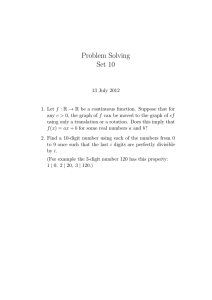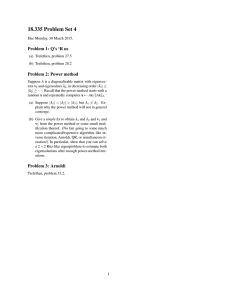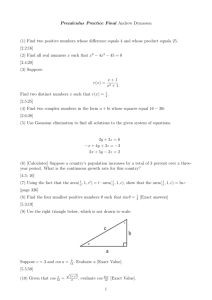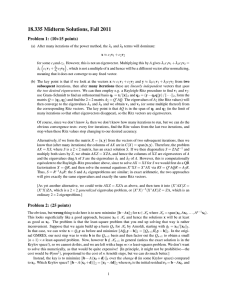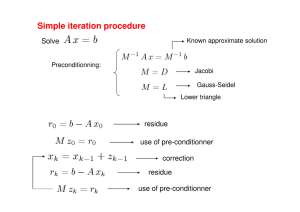18.335 Midterm, Fall 2011 Problem 1: (10+15 points)
advertisement
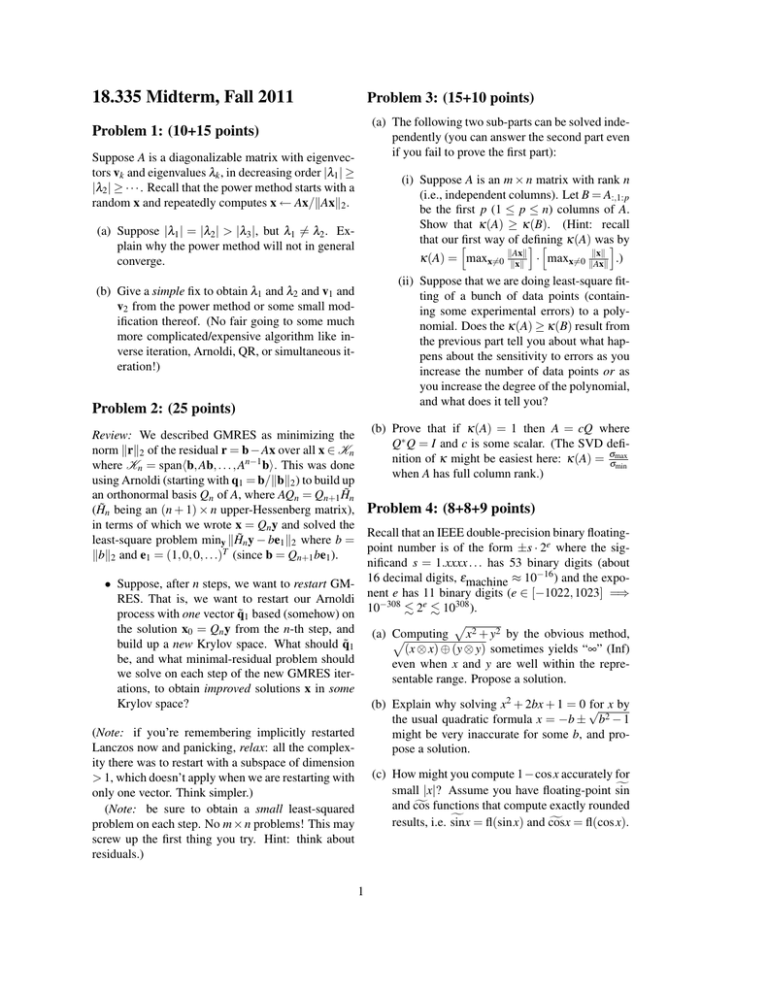
18.335 Midterm, Fall 2011 Problem 3: (15+10 points) (a) The following two sub-parts can be solved independently (you can answer the second part even if you fail to prove the first part): Problem 1: (10+15 points) Suppose A is a diagonalizable matrix with eigenvectors vk and eigenvalues λk , in decreasing order |λ1 | ≥ |λ2 | ≥ · · · . Recall that the power method starts with a random x and repeatedly computes x ← Ax/kAxk2 . (i) Suppose A is an m × n matrix with rank n (i.e., independent columns). Let B = A:,1:p be the first p (1 ≤ p ≤ n) columns of A. Show that κ(A) ≥ κ(B). (Hint: recall that our hfirst way of defining κ(A) wasi by i h kxk kAxk .) κ(A) = maxx6=0 kxk · maxx6=0 kAxk (a) Suppose |λ1 | = |λ2 | > |λ3 |, but λ1 6= λ2 . Explain why the power method will not in general converge. (ii) Suppose that we are doing least-square fitting of a bunch of data points (containing some experimental errors) to a polynomial. Does the κ(A) ≥ κ(B) result from the previous part tell you about what happens about the sensitivity to errors as you increase the number of data points or as you increase the degree of the polynomial, and what does it tell you? (b) Give a simple fix to obtain λ1 and λ2 and v1 and v2 from the power method or some small modification thereof. (No fair going to some much more complicated/expensive algorithm like inverse iteration, Arnoldi, QR, or simultaneous iteration!) Problem 2: (25 points) (b) Prove that if κ(A) = 1 then A = cQ where Review: We described GMRES as minimizing the Q∗ Q = I and c is some scalar. (The SVD definorm krk2 of the residual r = b − Ax over all x ∈ Kn nition of κ might be easiest here: κ(A) = σσmax min where Kn = spanhb, Ab, . . . , An−1 bi. This was done when A has full column rank.) using Arnoldi (starting with q1 = b/kbk2 ) to build up an orthonormal basis Qn of A, where AQn = Qn+1 H̃n (H̃n being an (n + 1) × n upper-Hessenberg matrix), Problem 4: (8+8+9 points) in terms of which we wrote x = Qn y and solved the Recall that an IEEE double-precision binary floatingleast-square problem miny kH̃n y − be1 k2 where b = point number is of the form ±s · 2e where the sigT kbk2 and e1 = (1, 0, 0, . . .) (since b = Qn+1 be1 ). nificand s = 1.xxxx . . . has 53 binary digits (about −16 • Suppose, after n steps, we want to restart GM- 16 decimal digits, εmachine ≈ 10 ) and the exponent e has 11 binary digits (e ∈ [−1022, 1023] =⇒ RES. That is, we want to restart our Arnoldi −308 . 2e . 10308 ). 10 process with one vector q̃1 based (somehow) on the solution x0 = Qn y from the n-th step, and (a) Computing px2 + y2 by the obvious method, p build up a new Krylov space. What should q̃1 (x ⊗ x) ⊕ (y ⊗ y) sometimes yields “∞” (Inf) be, and what minimal-residual problem should even when x and y are well within the reprewe solve on each step of the new GMRES itersentable range. Propose a solution. ations, to obtain improved solutions x in some Krylov space? (b) Explain why solving x2 + 2bx + 1 = 0 √ for x by the usual quadratic formula x = −b ± b2 − 1 (Note: if you’re remembering implicitly restarted might be very inaccurate for some b, and proLanczos now and panicking, relax: all the complexpose a solution. ity there was to restart with a subspace of dimension > 1, which doesn’t apply when we are restarting with (c) How might you compute 1−cos x accurately for f small |x|? Assume you have floating-point sin only one vector. Think simpler.) f functions that compute exactly rounded and cos (Note: be sure to obtain a small least-squared f = fl(sin x) and cosx f = fl(cos x). results, i.e. sinx problem on each step. No m × n problems! This may screw up the first thing you try. Hint: think about residuals.) 1
